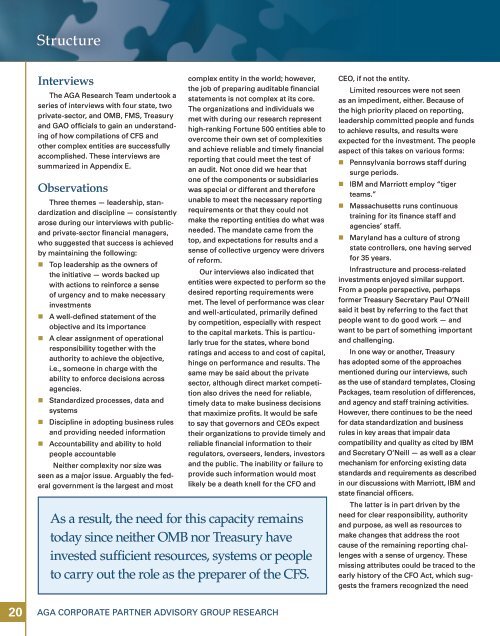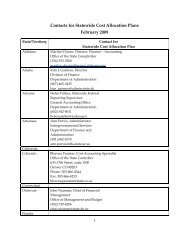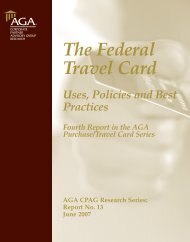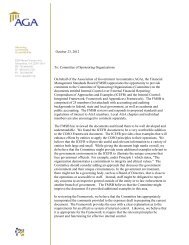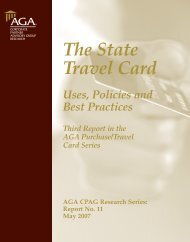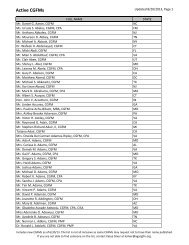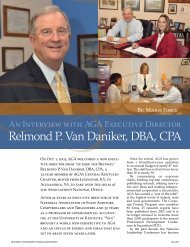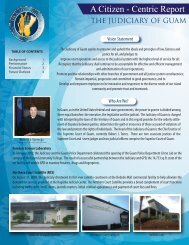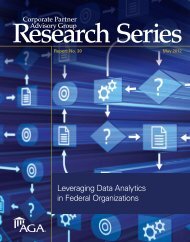Government-wide Financial Reporting - AGA
Government-wide Financial Reporting - AGA
Government-wide Financial Reporting - AGA
Create successful ePaper yourself
Turn your PDF publications into a flip-book with our unique Google optimized e-Paper software.
Structure<br />
Interviews<br />
The <strong>AGA</strong> Research Team undertook a<br />
series of interviews with four state, two<br />
private-sector, and OMB, FMS, Treasury<br />
and GAO officials to gain an understanding<br />
of how compilations of CFS and<br />
other complex entities are successfully<br />
accomplished. These interviews are<br />
summarized in Appendix E.<br />
Observations<br />
Three themes — leadership, standardization<br />
and discipline — consistently<br />
arose during our interviews with publicand<br />
private-sector financial managers,<br />
who suggested that success is achieved<br />
by maintaining the following:<br />
Top leadership as the owners of<br />
the initiative — words backed up<br />
with actions to reinforce a sense<br />
of urgency and to make necessary<br />
investments<br />
A well-defined statement of the<br />
objective and its importance<br />
A clear assignment of operational<br />
responsibility together with the<br />
authority to achieve the objective,<br />
i.e., someone in charge with the<br />
ability to enforce decisions across<br />
agencies.<br />
Standardized processes, data and<br />
systems<br />
Discipline in adopting business rules<br />
and providing needed information<br />
Accountability and ability to hold<br />
people accountable<br />
Neither complexity nor size was<br />
seen as a major issue. Arguably the federal<br />
government is the largest and most<br />
complex entity in the world; however,<br />
the job of preparing auditable financial<br />
statements is not complex at its core.<br />
The organizations and individuals we<br />
met with during our research represent<br />
high-ranking Fortune 500 entities able to<br />
overcome their own set of complexities<br />
and achieve reliable and timely financial<br />
reporting that could meet the test of<br />
an audit. Not once did we hear that<br />
one of the components or subsidiaries<br />
was special or different and therefore<br />
unable to meet the necessary reporting<br />
requirements or that they could not<br />
make the reporting entities do what was<br />
needed. The mandate came from the<br />
top, and expectations for results and a<br />
sense of collective urgency were drivers<br />
of reform.<br />
Our interviews also indicated that<br />
entities were expected to perform so the<br />
desired reporting requirements were<br />
met. The level of performance was clear<br />
and well-articulated, primarily defined<br />
by competition, especially with respect<br />
to the capital markets. This is particularly<br />
true for the states, where bond<br />
ratings and access to and cost of capital,<br />
hinge on performance and results. The<br />
same may be said about the private<br />
sector, although direct market competition<br />
also drives the need for reliable,<br />
timely data to make business decisions<br />
that maximize profits. It would be safe<br />
to say that governors and CEOs expect<br />
their organizations to provide timely and<br />
reliable financial information to their<br />
regulators, overseers, lenders, investors<br />
and the public. The inability or failure to<br />
provide such information would most<br />
likely be a death knell for the CFO and<br />
As a result, the need for this capacity remains<br />
today since neither OMB nor Treasury have<br />
invested sufficient resources, systems or people<br />
to carry out the role as the preparer of the CFS.<br />
CEO, if not the entity.<br />
Limited resources were not seen<br />
as an impediment, either. Because of<br />
the high priority placed on reporting,<br />
leadership committed people and funds<br />
to achieve results, and results were<br />
expected for the investment. The people<br />
aspect of this takes on various forms:<br />
Pennsylvania borrows staff during<br />
surge periods.<br />
IBM and Marriott employ “tiger<br />
teams.”<br />
Massachusetts runs continuous<br />
training for its finance staff and<br />
agencies’ staff.<br />
Maryland has a culture of strong<br />
state controllers, one having served<br />
for 35 years.<br />
Infrastructure and process-related<br />
investments enjoyed similar support.<br />
From a people perspective, perhaps<br />
former Treasury Secretary Paul O’Neill<br />
said it best by referring to the fact that<br />
people want to do good work — and<br />
want to be part of something important<br />
and challenging.<br />
In one way or another, Treasury<br />
has adopted some of the approaches<br />
mentioned during our interviews, such<br />
as the use of standard templates, Closing<br />
Packages, team resolution of differences,<br />
and agency and staff training activities.<br />
However, there continues to be the need<br />
for data standardization and business<br />
rules in key areas that impair data<br />
compatibility and quality as cited by IBM<br />
and Secretary O’Neill — as well as a clear<br />
mechanism for enforcing existing data<br />
standards and requirements as described<br />
in our discussions with Marriott, IBM and<br />
state financial officers.<br />
The latter is in part driven by the<br />
need for clear responsibility, authority<br />
and purpose, as well as resources to<br />
make changes that address the root<br />
cause of the remaining reporting challenges<br />
with a sense of urgency. These<br />
missing attributes could be traced to the<br />
early history of the CFO Act, which suggests<br />
the framers recognized the need<br />
20<br />
<strong>AGA</strong> Corporate Partner Advisory Group Research


